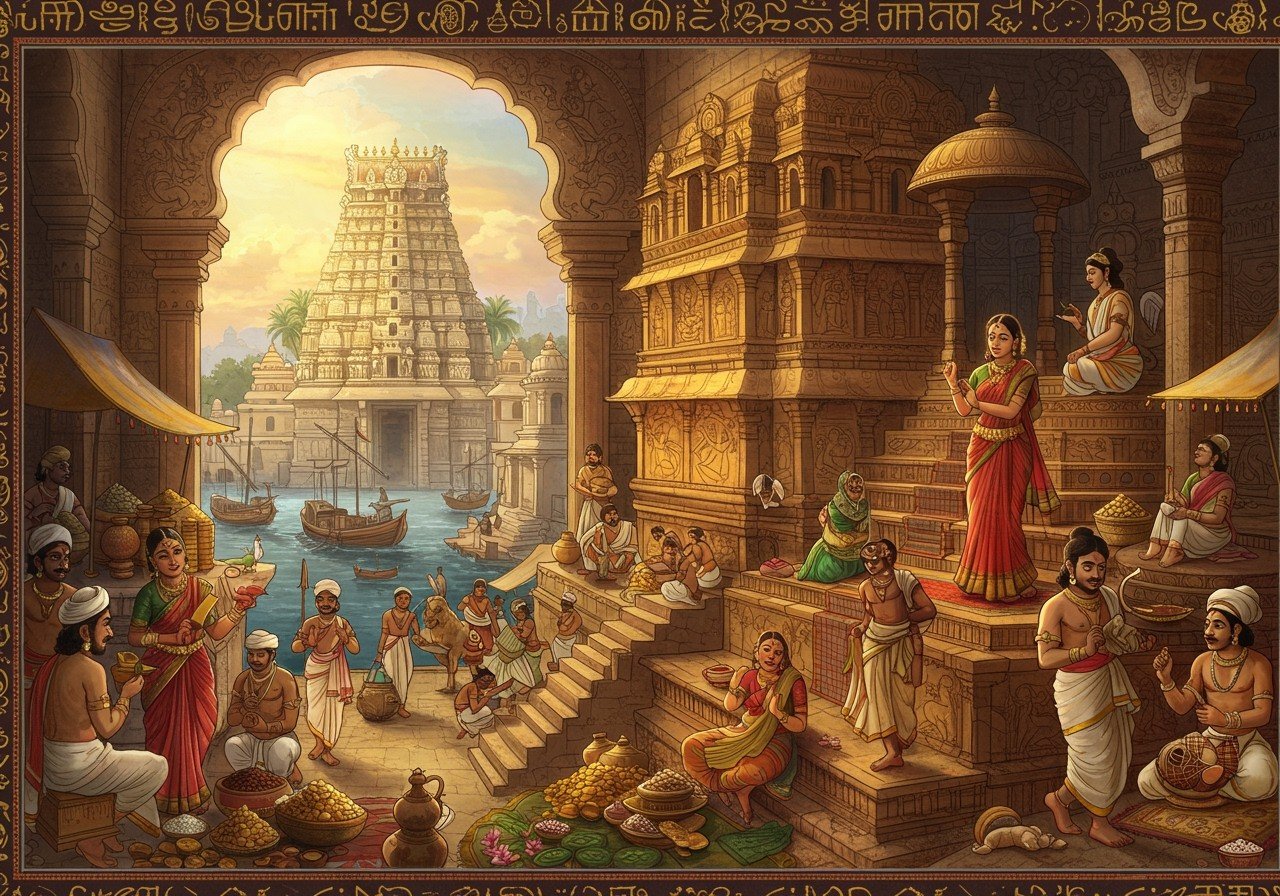
The Sangam Era (300-200 BCE to 300 CE), a pivotal period in South Indian history, particularly within the Tamil region known as Tamilakam (present-day Tamil Nadu, Kerala, parts of Andhra Pradesh, and Karnataka), is renowned for its rich cultural heritage. This era witnessed the birth of the earliest extant Tamil literature, offering invaluable insights into the lives, beliefs, and governance of the time. These literary works explored diverse themes, including love, war, governance, trade, and bereavement, providing a comprehensive picture of ancient Tamil society.
Sangam Period Dynasties
Three major dynasties dominated the Sangam era:
- Cholas: Based in the fertile Kaveri River valley, the Cholas were known for their naval prowess and extensive trade networks, extending their influence across South India and Southeast Asia.
- Cheras: Ruling the western parts of Tamilakam, including present-day Kerala, the Cheras were renowned for their trade relations with Romans, Chinese, and Arabs, playing a crucial role in the spice trade, particularly pepper and cardamom.
- Pandyas: Centered in Madurai, the Pandyas were patrons of Tamil literature and arts, fostering a vibrant intellectual and creative atmosphere that led to the flourishing of Sangam literature. Their patronage significantly contributed to the cultural and political identity of the region.
Smaller dynasties, such as the Pallavas and Velirs, also played a role in the political landscape. Governance during this period involved well-organized administrative systems, with records detailing land revenue, military organization, and public welfare. The practice of ‘Kudavolai’ (voting) in local governance highlights democratic elements within their society. Furthermore, women held significant roles in governance, as evidenced by inscriptions and literary references.
Sangam Period Religion
The Sangam era’s religious landscape was diverse:
- Nature deities: The worship of deities like Murugan (god of war), Mayon (associated with Vishnu), and Kotravai (goddess of fertility) was prevalent. These deities represented the forces of nature and played a central role in the spiritual beliefs of the people.
- Jainism and Buddhism: These religions coexisted with indigenous practices, influencing societal norms and contributing to the rich tapestry of religious thought during the Sangam period.
Temples and shrines served as vital community centers, hosting religious ceremonies and social gatherings. Rituals and festivals, like ‘Indra Vizha,’ reinforced community bonds and cultural identity. The concept of ‘Aram’ (righteousness) guided personal conduct and governance, as reflected in Sangam poetry. Priests and ascetics were revered for their spiritual guidance and knowledge.
Sangam Period Society
Sangam society was highly structured:
- Social stratification: Society was organized into distinct classes, including ‘Arasar’ (rulers), ‘Vaishyas’ (traders), ‘Velalars’ (agriculturists), and ‘Pulayas’ (laborers), each with specific roles and responsibilities.
- Agriculture and Trade: Agriculture formed the backbone of the economy, with the cultivation of rice, millet, and sugarcane being central. Trade complemented agriculture, with flourishing internal and external commerce contributing to economic prosperity.
Urban centers like Madurai, Kaveripattinam, and Uraiyur thrived as hubs of trade, culture, and administration. Art and craft, including pottery, metallurgy, and weaving, showcased advanced skills and aesthetic sensibilities. Women actively participated in agriculture, trade, and even warfare. Prominent women poets, like ‘Avvaiyars,’ made significant contributions to Sangam literature. Education was imparted through ‘Gurukulam’ (traditional schools), where students learned literature, philosophy, and martial arts. Social practices, such as ‘Kanyashulkam’ (bride price) and ‘Sati’ (self-immolation by widows), reflected complex social traditions.
How Poojn.in Connects You to Ancient Tamil Heritage
Poojn.in, India’s leading cultural goods and services store, offers a wide range of products that connect you with the rich spiritual traditions of the Sangam Era. We provide:
- Shiva Lingam and Nandi Sets: Honor Lord Shiva, a prominent deity during the Sangam period, with these beautifully crafted sets.
- Brass Trishuls: Acquire authentic brass Trishuls, symbolic of Lord Shiva’s power, reflecting the Sangam era’s metalworking traditions.
- Sacred Threads: Connect with ancient rituals using sacred threads crafted according to traditional specifications.
- Learn More: Explore our blog post on Hindu Temple Architecture to understand the significance and symbolism of temples, central to Sangam era society.
Visit www.poojn.in to discover a wide selection of puja items and resources that help you connect with the rich spiritual heritage of the Sangam Era.
Conclusion
The Sangam Era (300-200 BCE to 300 CE) stands as a testament to Tamil Nadu’s rich cultural legacy. Its dynasties, religious practices, and societal structures laid the groundwork for future developments in South Indian history and continue to shape Tamil identity today. Sangam literature provides invaluable insights into this remarkable period, allowing us to appreciate the values, beliefs, and governance that shaped this era.


